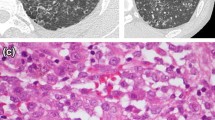Abstract
To compare the subtle pulmonary parenchymal morphologic changes with ventilation function in patients with silicosis, the conventional CT, high resolution CT and technegas ventilation SPECT were performed. In 25 silicotic patients and six controls, the pulmonary ventilation state was evaluated by an index called the coefficient of variation (CV), which expresses the subliminal heterogeneous distribution of technegas in the lungs. The results showed that with silicosis the CV value is significantly higher than that without silicosis. The CV value was proved by multifactorial analysis to independently reflect the extent of the appearance of small scattered interstitial findings such as nodules, septal thickening and bulla, which were typical findings for silicosis. The CV value calculated from the technegas SPECT correlated well with the severity of silicosis. It is considered that the CV value can also express the functional state of the silicotic lung.
Similar content being viewed by others
References
Theriault GP, Peters JM, Johnson WM. Pulmonary function and roentgenographic changes in granite dust exposure.Arch Environ Health 28: 23–27, 1974.
Craighead JE, Vallythan NV. Cryptic pulmonary lesions in workers occupationally exposed to dust containing silica.JAMA 244: 1939–1941, 1980.
Bégin R, Ostiguy G, Fillion R, Colman N. Computed to- mography scan in the early detection of silicosis.Am Rev Respir Dis 144: 697–705, 1991.
Akira M, Yokoyama K, Yamamoto S, Higashihara T, Morinaga K, Kita N, et al. Early asbestosis: evaluation with high-resolution CT.Radiology 178: 409–416, 1991.
Bégin R, Bergeron D, Samson L, Boctor M, Cantin A. CT assessment of silicosis in exposed workers.Am J Roentgenol 148: 509–514, 1987.
Bégin R, Ostiguy G, Fillion R, Colman N, Bertrand P. Computed tomography in the early detection of asbestosis.Br J Ind Med 50: 689–698, 1993.
Bergin CJ, Muller NL, Vedal S, Chan-Yeung M. CT in silicosis: correlation with plain films and pulmonary function tests.Am J Roentgenol 146: 477–483, 1986.
Collins LC, Willing S, Bretz R, Harty M, Lane E, Anderson WH. High-resolution CT in simple coal workers’ pneumoconiosis, lack of correlation with pulmonary function tests and arterial blood gas values.Chest 104: 1156–1162, 1993.
Bégin R, Ostiguy G, Cantin A, Bergeron D. Lung function in silica-exposed workers, a relationship to disease severity assessed by CT scan.Chest 94: 539–545, 1988.
Burch WM, Sullivan PJ, McLaren CJ. Technegas: a new ventilation agent for lung scanning.Nucl Med Commun 7: 865–871, 1986.
International Labour Office. Guidelines for the use of the ILO International Classification of Radiographs of Pneumoconioses. Revised edition. Occupational Safety and Health Series. No. 22 (Rev 80). Geneva: International Labour Office, 1980.
Gurney JW. Cross-sectional physiology of the lung.Radiology 178: 1–10, 1991.
Christman JW, Emerson RJ, Graham WGB, Davis GS. Mineral dust and cell recovery from the bronchoalveolar lavage of healthy Vermont granite workers.Am Rev Respir Dis 132: 393–399, 1985.
Mannting F, Morgan MG, Hedenstrom H, Maripuu E, Hedenstierna G. A comparative study of Xe-133 and Tc- 99m-gas for assessment of regional ventilation.Eur J Nucl Med 16: 429, 1990.
Rimkus DS, Ashbum WL. Lung ventilation scanning with a new carbon particle radioaerosol (Technegas).Clin Nucl Med 15: 222–226, 1990.
Sullivan PJ, Burke WM, Burch WM, Lomas FE. A clinical comparison of Technegas and xenon-133 in 50 patients with suspected pulmonary embolus.Chest 94: 300–304, 1988.
Peltier P, Faucal P, Chetanneau A, Chatal JF. Comparison of technetium-99m aerosol and krypton-81 m in ventilation studies for the diagnosis of pulmonary embolism.Nucl Med Commun 11: 631–638, 1990.
Hilson AJW, Pavia D, Diamond PD, Agnew JE. An ultrafine 99m-Tc-aerosol (Technegas) for lung ventilation scintig-raphy—A comparison with Kr-81m.J Nucl Med 30: 744, 1989.
Zwinenburg A, Royen EV, Dongen AV, Zanin D. Experience with99mTc-Technegas as a ventilation tracer; comparison with81mKr-gas.Eur J Nucl Med 16: 440, 1990.
Lemb M, Oei TH, Günther B. Technegas: a study of particle structure, size and distribution.Eur J Nucl Med 20: 576–579, 1993.
Bessis L, Callard P, Gotheil C, Biaggi A, Grenier P. Highresolution CT of parenchymal lung disease: precise correlation with histologic findings.Radiographics 12: 45–58, 1992.
Akira M, Higashihara T, Yokoyama K, Yamamoto S, Kita N, Morimoto S, et al. Radiographie type p pneumoconiosis: high-resolution CT.Radiology 171: 117–123, 1989.
Author information
Authors and Affiliations
Rights and permissions
About this article
Cite this article
Zhang, X., Hirano, H., Yamamoto, K. et al. Technegas ventilation SPECT for evaluating silicosis in comparison with computed tomography. Ann Nucl Med 10, 165–170 (1996). https://doi.org/10.1007/BF03165388
Received:
Accepted:
Issue Date:
DOI: https://doi.org/10.1007/BF03165388




